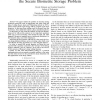Free Online Productivity Tools
i2Speak
i2Symbol
i2OCR
iTex2Img
iWeb2Print
iWeb2Shot
i2Type
iPdf2Split
iPdf2Merge
i2Bopomofo
i2Arabic
i2Style
i2Image
i2PDF
iLatex2Rtf
Sci2ools
CORR
2007
Springer
2007
Springer
Coding Solutions for the Secure Biometric Storage Problem
—The paper studies the problem of securely storing biometric passwords, such as fingerprints and irises. With the help of coding theory Juels and Wattenberg derived in 1999 a scheme where similar input strings will be accepted as the same biometric. In the same time nothing could be learned from the stored data. They called their scheme a fuzzy commitment scheme. In this paper we will revisit the solution of Juels and Wattenberg and we will provide answers to two important questions: what type of error-correcting codes should be used and what happens if biometric templates are not uniformly distributed, i.e. the biometric data come with redundancy. Answering the first question will lead us to the search for lowrate large-minimum distance error-correcting codes which come with efficient decoding algorithms up to the designed distance. In order to answer the second question we relate the rate required with a quantity connected to the “entropy” of the string, trying to estimate a...
| Added | 13 Dec 2010 |
| Updated | 13 Dec 2010 |
| Type | Journal |
| Year | 2007 |
| Where | CORR |
| Authors | Davide Schipani, Joachim Rosenthal |
Comments (0)

